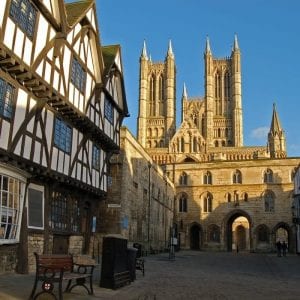A project involving researchers at the University of Lincoln and the team at Lincoln Cathedral will see members of the public using a new Smartphone application to preserve and share their memories of events associated with local historic sites.
The ‘Crowd-Curated History’ project, being led by academics from Media, Computer Science and History subject areas at the University of Lincoln, UK, will enable visitors to Lincoln Cathedral, and other local historic sites, to contribute their stories to the body of knowledge about exhibits, objects and places.
The research was inspired by conversations with tour guides, who noted that visitors on tours often tell fascinating stories about how places played significant roles in important life events; such as weddings, graduations, first kisses with future spouses, or inspiration for works of art. Often, these stories become incorporated informally in tours of those places, through guides passing the stories on. However, the stories are rarely recorded formally, and when guides leave, the stories are lost.
The project will allow tour guides, in collaboration with members of the public, to be more directly involved in recording and preserving local community history.
It will explore the use of ‘Augmented Reality’ (AR) technology for capturing and sharing these community histories. AR software allows users to see graphics, video and audio data displayed ‘on top of’ their view of the real world, when using the phone’s video camera and display screen. This software will allow visitors to attach text, speech and images as virtual tags to exhibits, items or areas of interest, where subsequent visitors can play them back.
Also included will be additional information, anecdotes and stories passed down from previous generations.
Project lead, Dr Andrew Elliott from the Lincoln School of Media, said: “Our project is designed to capture local history from those who are frequently shut out of the process. Traditionally we learn history through three methods; education, public history such as visiting historical sites and museums, and cultural pursuits such as watching films and reading novels. The problem is that these are typically led by someone who decides what that history means, and then feeds it back to you.
“We will explore a model in which visitors become the co-creators and curators of the local historical narrative.”
The research relies on technical expertise from the University’s School of Computer Science, drawing on Dr John Murray’s research with crowd sourcing platforms, Dr Conor Linehan’s expertise in interaction design and Dr Patrick Dickinson’s work on Augmented Reality technology.
Dr Dickinson said: “The idea is that visitors to a museum or historical site can hold their phone over a specific exhibit to find out additional information, but they will also be given the chance to record their own experiences of the site. This will provide a community oral history linked to the exhibits and artefacts, creating a deeper sense of ownership.”
The Cathedral’s head of fundraising, Anne Irving, added: “This project makes a valuable contribution to the Lincoln Cathedral Connected project, for which we hope to secure Heritage Lottery Funding in May this year. We are delighted to be to working with the University of Lincoln on this innovative and exciting initiative.”
Researchers will initially gather together visitors to the cathedral to discuss their experiences and the relevance of the cathedral to their own lives and history. The software will then be developed in close collaboration with the Cathedral over the summer, and will be evaluated in December 2014.
If you would like to take part in this project please contact Dr Andrew Elliott by e-mailing aelliott@lincoln.co.uk
